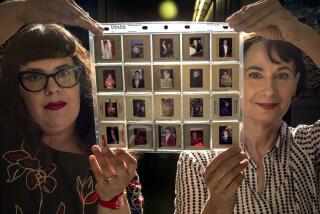An Anne Frank Picture Album : Previously Unseen Photos Part of Traveling Exhibition
- Share via
Four years ago a mysterious package containing a photo album of the Anne Frank family arrived at the Anne Frank Center of the Netherlands.
Postmarked Hamburg, Germany, the package contained no further identification, and center officials theorized that the album had been privately held since World War II or rediscovered and mailed.
Although the pictures embellished Anne Frank’s story, center officials chose not to display them because they wanted the exhibit in the Anne Frank House to focus on the causes of Nazism rather than on the tragedy of one 15-year-old girl.
Philosophy Changed
Recently they changed that philosophy. A touring 800-piece exhibit, “Anne Frank in the World: 1929-1945,” contains about 100 previously unseen photos from the album and from the Frank family in Switzerland.
Interweaving prints of Ann Frank in school, at the beach and playing jump rope with photos of the Nazi world closing in around her, the exhibit is ready today, on what would have been Frank’s 57th birthday, for its Los Angeles showing.
Sponsored by the Jewish Federation Council, it will be shown in a converted grocery store at 9331 Wilshire Blvd., Beverly Hills, from Sunday through July 13. There is a suggested donation of $2 for adults and $1 for seniors for admission. Children under 12 free.
Hours are from 10 a.m. to 6 p.m Monday through Friday, until 8 p.m. on Thursday and from from 11 a.m. to 7 p.m. on Sunday. The exhibit will be closed July 4 and on Saturdays.
Bauco van der Wal, international director of the Anne Frank Center of the Netherlands, believes that when the Nazis discovered the Frank family hiding in a secret annex above Otto Frank’s office during World War II, they treated the album like all “Jewish property” and sent it to Germany.
Anne Frank was sent to Auschwitz and then to the Bergen-Belsen concentration camp where she contracted typhus and died. Two years later, her father published her now-famous diary.
Speaking by telephone from New York, Van der Wal said the new pictures help explain that diary and the center decided to display the photos after opening an office in New York two years ago.
“We thought this would be a good way to introduce ourselves--to travel with a large exhibition,” he said. “We also found that a lot of the historical information about the Nazi period emphasized the outcome. If you only look at the concentration camps, you can’t understand it. You have to look at the historical development.”
The exhibit traces that development, starting with pictures of Frankfurt where the Frank family lived for generations.
It shifts to the rise of Hitler, to events in Amsterdam, where Otto Frank moved his family in 1933, and to the years after the war.
Van der Wal said that the exhibit, which will be seen in about 30 U.S. cities, teaches two lessons.
“It makes you realize that on one hand the Nazi movement was really attractive,” he said. “People who had never been on holidays were able to go on them. The Nazis even sent people for propaganda purposes.
‘They Provided Jobs’
“They promised people a car, from which came the famous Volkswagen. They provided jobs. We believe all that is very important.
“On the other hand what I think comes out very clearly is that Anne Frank was such a perfectly normal girl who liked to roller skate, who liked to be on the beach, who liked to do everything that every suburban girl today would love to do.
“By showing these pictures and the normality of a photo album we show that the victims of this period were not exotic, faraway people but very ordinary and that it could happen to any one of us.”
More to Read
The biggest entertainment stories
Get our big stories about Hollywood, film, television, music, arts, culture and more right in your inbox as soon as they publish.
You may occasionally receive promotional content from the Los Angeles Times.










